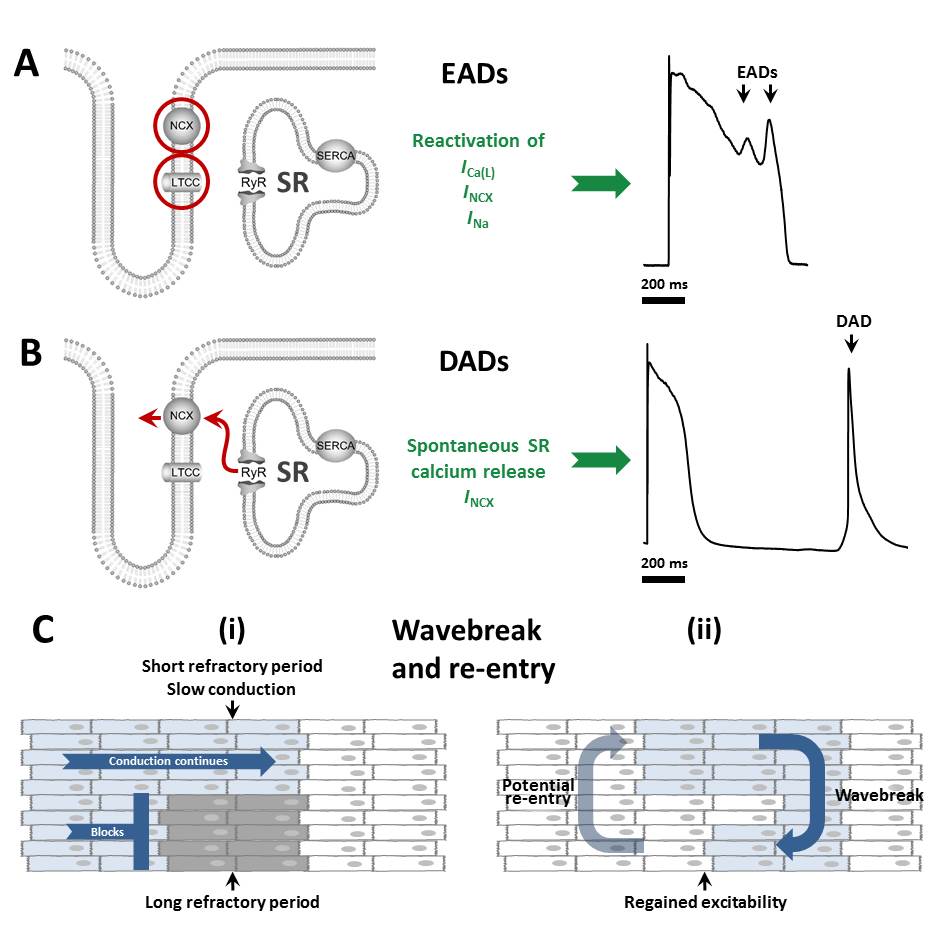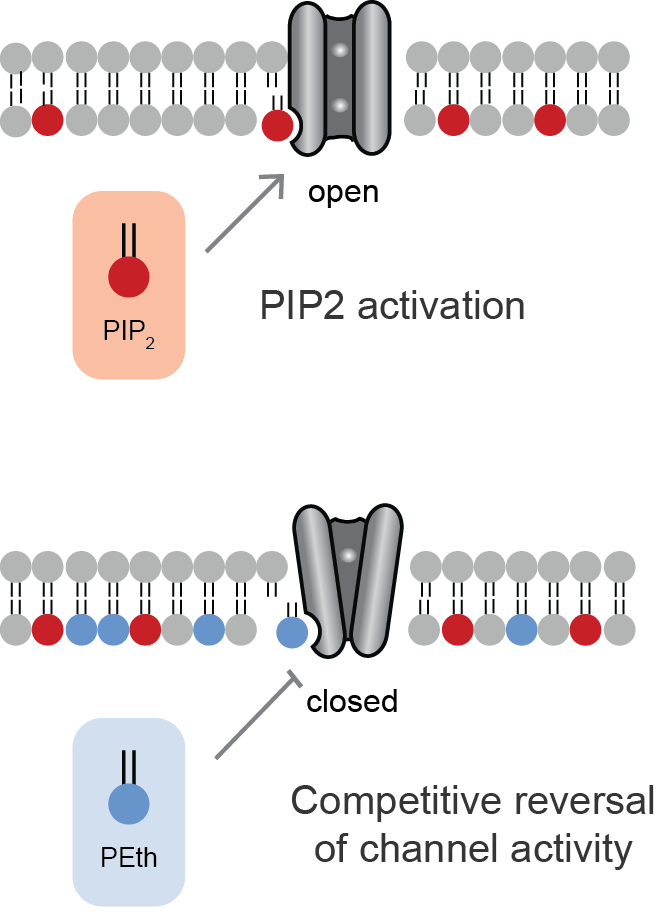|
KvLQT1
Kv7.1 (KvLQT1) is a potassium ion channel, channel protein whose primary subunit in humans is encoded by the ''KCNQ1'' gene. Its mutation causes Long QT syndrome, Kv7.1 is a voltage and Lipid-gated ion channels, lipid-gated potassium channel present in the cell membranes of cardiac tissue and in inner ear neurons among other tissues. In the cardiac cell (biology), cells, Kv7.1 mediates the IKs (or slow delayed rectifying K+) current that contributes to the repolarization of the cell, terminating the cardiac action potential and thereby the heart's Muscle contraction, contraction. It is a member of the KCNQ channels, KCNQ family of potassium channels. Structure KvLQT1 is made of six membrane-spanning domains S1-S6, two intracellular domains, and a pore loop. The KvLQT1 channel is made of four KCNQ1 subunits, which form the actual ion channel. Function This gene encodes a protein for a voltage-gated potassium channel required for the repolarization phase of the cardiac ac ... [...More Info...] [...Related Items...] OR: [Wikipedia] [Google] [Baidu] |
KCNE1
Potassium voltage-gated channel subfamily E member 1 is a protein that in humans is encoded by the ''KCNE1'' gene In biology, the word gene has two meanings. The Mendelian gene is a basic unit of heredity. The molecular gene is a sequence of nucleotides in DNA that is transcribed to produce a functional RNA. There are two types of molecular genes: protei .... Voltage-gated potassium channels (Kv) represent the most complex class of voltage-gated ion channels from both functional and structural standpoints. Their diverse functions include regulating neurotransmitter release, heart rate, insulin secretion, neuronal excitability, epithelial electrolyte transport, smooth muscle contraction, and cell volume.KCNE1is one of five members of the KCNE family of Kv channel ancillary or β subunits. It is also known as minK (minimal potassium channel subunit). Function KCNE1 is primarily known for modulating the cardiac and epithelial Kv channel alfa subunit, KCNQ1. KCNQ1 and KCNE ... [...More Info...] [...Related Items...] OR: [Wikipedia] [Google] [Baidu] |
Long QT Syndrome
Long QT syndrome (LQTS) is a condition affecting repolarization (relaxing) of the heart after a heartbeat, giving rise to an abnormally lengthy QT interval. It results in an increased risk of an irregular heartbeat which can result in fainting, drowning, seizures, or sudden death. These episodes can be triggered by exercise or stress. Some rare forms of LQTS are associated with other symptoms and signs including deafness and periods of muscle weakness. Long QT syndrome may be present at birth or develop later in life. The inherited form may occur by itself or as part of larger genetic disorder. Onset later in life may result from certain medications, low blood potassium, low blood calcium, or heart failure. Medications that are implicated include certain antiarrhythmics, antibiotics, and antipsychotics. LQTS can be diagnosed using an electrocardiogram (EKG) if a corrected QT interval of greater than 450–500 milliseconds is found, but clinical findings, other EKG fe ... [...More Info...] [...Related Items...] OR: [Wikipedia] [Google] [Baidu] |
PPP1CA
Serine/threonine-protein phosphatase PP1-alpha catalytic subunit is an enzyme that in humans is encoded by the ''PPP1CA'' gene. Function The protein encoded by this gene is one of the three catalytic subunits of protein phosphatase 1 (PP1). PP1 is a serine/threonine specific protein phosphatase known to be involved in the regulation of a variety of cellular processes, such as cell division, glycogen metabolism, muscle contractility, protein synthesis, and HIV-1 viral transcription. Increased PP1 activity has been observed in the end stage of heart failure. Studies in both human and mice suggest that PP1 is an important regulator of cardiac function. Three alternatively spliced transcript variants encoding different isoforms have been found for this gene. Interactive pathway map Interactions PPP1CA has been shown to interact with: * AKAP11, * BCL2-like 1, * BCL2L2, * BRCA1, * CDC5L, * Host cell factor C1, * KvLQT1, * LMTK2, * PHACTR3, * PPP1R15A, * PPP1 ... [...More Info...] [...Related Items...] OR: [Wikipedia] [Google] [Baidu] |
Lipid-gated Ion Channels
Lipid-gated ion channels are a class of ion channels whose conductance of ions through the membrane depends directly on lipids. Classically the lipids are membrane resident anionic signaling lipids that bind to the transmembrane domain on the inner leaflet of the plasma membrane with properties of a classic ligand. Other classes of lipid-gated channels include the mechanosensitive ion channels that respond to lipid tension, thickness, and hydrophobic mismatch. A lipid ligand differs from a lipid Cofactor (biochemistry), cofactor in that a Ligand (biochemistry), ligand derives its function by dissociating from the channel while a cofactor typically derives its function by remaining bound. PIP2-gated channels Phosphatidylinositol 4,5-bisphosphate (PIP2) was the first and remains the best studied lipid to gate ion channels. PIP2 is a cell membrane lipid, and its role in gating ion channels represents a novel role for the molecule. Kir channels: PIP2 binds to and directly activate ... [...More Info...] [...Related Items...] OR: [Wikipedia] [Google] [Baidu] |
KCNE3
Potassium voltage-gated channel, Isk-related family, member 3 (KCNE3), also known as MinK-related peptide 2 (MiRP2) is a protein that in humans is encoded by the ''KCNE3'' gene. Function Voltage-gated potassium channels (Kv) represent the most complex class of voltage-gated ion channels from both functional and structural standpoints. Their diverse functions include regulating neurotransmitter release, heart rate, insulin secretion, neuronal excitability, epithelial electrolyte transport, smooth muscle contraction, and cell volume. KCNE3 encodes a member of the five-strong KCNE family of voltage-gated potassium (Kv) channel ancillary or β subunits. KCNE3 is best known for modulating the KCNQ1 Kv α subunit, but it also regulates hERG, Kv2.1, Kv3.x, Kv4.x and Kv12.2 in heterologous co-expression experiments and/or in vivo. Co-assembly with KCNE3 converts KCNQ1 from a voltage-dependent delayed rectifier K+ channel to a constitutively open K+ channel with an almost linear curre ... [...More Info...] [...Related Items...] OR: [Wikipedia] [Google] [Baidu] |
AKAP9
A-kinase anchor protein 9 is a protein that in humans is encoded by the ''AKAP9'' gene. AKAP9 is also known as Centrosome- and Golgi-localized protein kinase N-associated protein (CG-NAP) or AKAP350 or AKAP450 Function The A-kinase anchor proteins (AKAPs) are a group of structurally diverse proteins which have the common function of binding to the regulatory subunit of protein kinase A (PKA) and confining the holoenzyme to discrete locations within the cell. This gene encodes a member of the AKAP family. Alternate splicing of this gene results in many isoforms that localize to the centrosome and the Golgi apparatus, and interact with numerous signaling proteins from multiple signal transduction pathways. These signaling proteins include type II protein kinase A, protein kinase N1, serine/threonine kinase protein kinase N, protein phosphatase 1, protein phosphatase 2a, PRKCE, protein kinase C-epsilon and PDE4D, phosphodiesterase 4D3. Interactions AKAP9 has been shown to Prot ... [...More Info...] [...Related Items...] OR: [Wikipedia] [Google] [Baidu] |
KCNQ Channels
KCNQ genes encode family members of the Kv7 potassium channel family. These include Kv7.1 (KCNQ1) - KvLQT1, Kv7.2 ( KCNQ2), Kv7.3 ( KCNQ3), Kv7.4 (KCNQ4), and Kv7.5 (KCNQ5 Potassium voltage-gated channel subfamily KQT member 5 is a protein that in humans is encoded by the ''KCNQ5'' gene. This gene is a member of the KCNQ potassium channel gene family that is differentially expressed in subregions of the brain and i ...). Four of these (KCNQ2-5) are expressed in the nervous system. They constitute a group of low-threshold voltage-gated K+ channels originally termed the ‘M-channel’ (see M-current). The M-channel name comes from the classically described mechanism wherein the activation of the muscarinic acetylcholine receptor deactivated this channel. References Potassium channels Ion channels {{Molecular-biology-stub ... [...More Info...] [...Related Items...] OR: [Wikipedia] [Google] [Baidu] |
Physiology
Physiology (; ) is the science, scientific study of function (biology), functions and mechanism (biology), mechanisms in a life, living system. As a branches of science, subdiscipline of biology, physiology focuses on how organisms, organ systems, individual organ (biology), organs, cell (biology), cells, and biomolecules carry out chemistry, chemical and physics, physical functions in a living system. According to the classes of organisms, the field can be divided into clinical physiology, medical physiology, Zoology#Physiology, animal physiology, plant physiology, cell physiology, and comparative physiology. Central to physiological functioning are biophysics, biophysical and biochemical processes, homeostasis, homeostatic control mechanisms, and cell signaling, communication between cells. ''Physiological state'' is the condition of normal function. In contrast, ''pathology, pathological state'' refers to abnormality (behavior), abnormal conditions, including human diseases. ... [...More Info...] [...Related Items...] OR: [Wikipedia] [Google] [Baidu] |
Tetrameric Protein
A tetrameric protein is a protein with a quaternary structure of four subunits (tetrameric). Homotetramers have four identical subunits (such as glutathione S-transferase), and heterotetramers are complexes of different subunits. A tetramer can be assembled as dimer of dimers with two homodimer subunits (such as sorbitol dehydrogenase), or two heterodimer subunits (such as hemoglobin). Subunit interactions in tetramers The interactions between subunits forming a tetramer is primarily determined by non covalent interaction. Hydrophobic effects, hydrogen bonds and electrostatic interactions are the primary sources for this binding process between subunits. For homotetrameric proteins such as sorbitol dehydrogenase (SDH), the structure is believed to have evolved going from a monomeric to a dimeric and finally a tetrameric structure in evolution. The binding process in SDH and many other tetrameric enzymes can be described by the gain in free energy which can be determined ... [...More Info...] [...Related Items...] OR: [Wikipedia] [Google] [Baidu] |
Potassium
Potassium is a chemical element; it has Symbol (chemistry), symbol K (from Neo-Latin ) and atomic number19. It is a silvery white metal that is soft enough to easily cut with a knife. Potassium metal reacts rapidly with atmospheric oxygen to form flaky white potassium peroxide in only seconds of exposure. It was first isolated from potash, the ashes of plants, from which its name derives. In the periodic table, potassium is one of the alkali metals, all of which have a single valence electron in the outer electron shell, which is easily removed to create cation, an ion with a positive charge (which combines with anions to form salts). In nature, potassium occurs only in ionic salts. Elemental potassium reacts vigorously with water, generating sufficient heat to ignite hydrogen emitted in the reaction, and burning with a lilac-flame color, colored flame. It is found dissolved in seawater (which is 0.04% potassium by weight), and occurs in many minerals such as orthoclase, a ... [...More Info...] [...Related Items...] OR: [Wikipedia] [Google] [Baidu] |
PRKACA
The catalytic subunit α of protein kinase A is a key regulatory enzyme that in humans is encoded by the ''PRKACA'' gene. This enzyme is responsible for phosphorylating other proteins and substrates, changing their activity. Protein kinase A catalytic subunit (PKA Cα) is a member of the Protein kinase#Protein kinase groups, AGC kinase family (protein kinases A, Protein kinase G, G, and Protein kinase C, C), and contributes to the control of cellular processes that include glucose metabolism, cell division, and contextual memory. PKA Cα is part of a larger protein complex that is responsible for controlling when and where proteins are phosphorylated. Defective regulation of PKA holoenzyme activity has been linked to the progression of cardiovascular disease, certain endocrine disorders and cancers. Discovery Edmond H. Fischer and Edwin G. Krebs at the University of Washington discovered PKA in the late 1950s while working through the mechanisms that govern glycogen phosphoryla ... [...More Info...] [...Related Items...] OR: [Wikipedia] [Google] [Baidu] |




